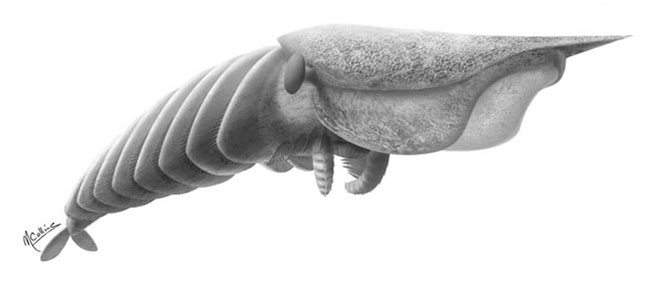Ancient Creature Was a Miniature Monster

A fossil from famous shale deposits in Canada was thought to be unremarkable, but a new study finds that it's actually the remains of a 500-million-year-old monster-looking predator.
The Burgess Shale (a UNESCO World Heritage Site in the Canadian Rockies of British Columbia) has yielded exceptionally well-preserved fossils that present a remarkable snapshot of Cambrian marine life from 505 million years ago.
The first fragments of the monster fossil (a species called Hurdia victoria) were described nearly 100 years ago, and at the time, they were thought to be part of a crustacean-like animal, and other parts were subsequently described as multiple organisms including jellyfish, sea cucumbers and other arthropods.
Now it's clear that Hurdia was a relatively large predatory animal, possibly up to 1.5 feet (0.5 meter) in length. It had a segmented body with a head bearing a pair of spiny claws and a circular jaw structure with many teeth.
"Finding a complete fossilized animal is extremely rare. Soft tissues tend to decay rapidly after death, and harder parts tend to disarticulate or break into pieces, often leaving very few clues as to what the original animals looked like," said Jean-Bernard Caron of the Royal Ontario Museum, which houses many Burgess Shale fossils, including pieces of Hurdia.
A study of the fossil by Caron and his colleagues, detailed in the March 20 issue of the journal Science, sheds light on the origin of the largest group of living animals, the arthropods — a group that includes insects, crustaceans, spiders, millipedes and centipedes.
Clues to the real nature of Hurdia have been accumulating over the years as new specimens have either been collected or discovered in museum collections. The last piece of the puzzle was found when a specimen turned up in storage cabinets at the Smithsonian National Museum of Natural History in Washington, D.C. The specimen, the best-preserved of all the relevant fragments, was collected by Charles Walcott in the early 20th century.
Sign up for the Live Science daily newsletter now
Get the world’s most fascinating discoveries delivered straight to your inbox.
This specimen had lain untouched for decades until researchers in the 1970s and 80s classified it first as an arthropod and then as an unusual specimen of the famous monster predator Anomalocaris. The new description of Hurdia shows that it was actually related to this other beast.
One feature does set Hurdia apart from Anomalocaris — a unique, large, three-part shell that projects out from the front of the animal's head.
"This structure is unlike anything seen in other fossils or living arthropods," said Allison Daley, the team's lead researcher from Uppsala University in Sweden, who worked on the fossils for her doctoral thesis.
"It was hard to tell whether the box-like shell structure came to lie so far forward after the animal died, or when it molted its hard parts, or if this was how it really looked when alive," said Greg Edgecombe, a paleontologist at the Natural History Museum. "The way the fossil is preserved made us decide that it really had this structure in front of its head, but we still don't know what it was for."
Daley said: "In many animals, a shell or carapace is used to protect the soft-parts of the body, as you would see in a crab or lobster, but this structure in Hurdia is empty and does not cover or protect the rest of the body. We can only guess at what its function might have been."
Also unknown is exactly what this mini predator would have snacked on.
"We have no direct evidence (such as preserved gut contents or fecal matter) as to what Hurdia would have been eating, but we can guess that as a top predator it was trying to eat anything it could catch," Daley told LiveScience in an email. "In the Cambrian marine environment, this could include trilobites or other arthropods, molluscs, marine worms, and even other predators."
The Hurdia fossil also reveals details of the gills associated with the body, some of the best preserved in the fossil record. Most of the body is covered in the gills, which were probably necessary to provide oxygen to such a large, actively swimming animal.
Hurdia and Anomalocaris are both early offshoots of the evolutionary lineage that led to the arthropods. They reveal details of the origins of important features that define the modern arthropods, such as compound eyes and limbs with filaments used for breathing.
- Petrified Animals Died Quickly
- Fossil News, Images and Information
- Images: Small Sea Monsters










